Micro-CHP systems offer an eco-friendly solution for home energy, combining heat and power generation. Top options include the Viessmann Vitotwin 300-W, known for its high efficiency, and the Vaillant Ecopower 1.0, which modulates output based on energy needs. The Yanmar CP5WN and Honda MCHP1.0K2 provide significant CO2 reductions, while the Senertec Dachs G5.5 offers versatile fuel options. Other remarkable systems are the Aisin GECC60A2N, BDR Thermea Microchp, Ceres Power SteelCell, and Panasonic Ene-Farm. These systems can reduce your carbon footprint by up to 50% and cut energy costs by 30-40%. Exploring each system's unique features will help you make an informed decision.
Viessmann Vitotwin 300-W
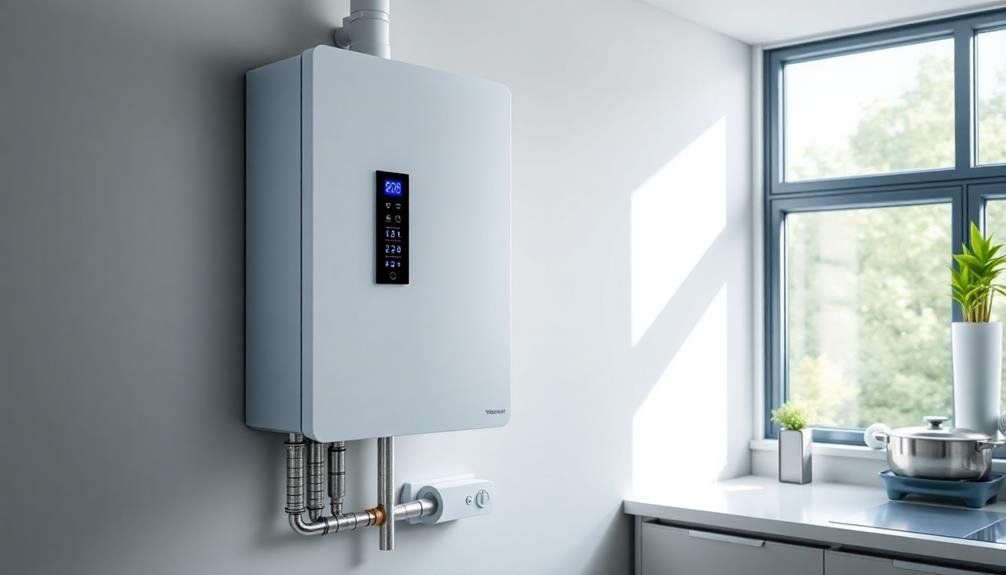
As homeowners seek more efficient energy solutions, the Viessmann Vitotwin 300-W stands out as a leading micro-CHP system. This innovative unit combines heat and power generation, offering you a compact and eco-friendly alternative to traditional heating methods.
The Vitotwin 300-W utilizes Stirling engine technology to produce both heat and electricity simultaneously, maximizing energy efficiency in your home.
You'll appreciate the system's ability to generate up to 1 kW of electrical power while providing up to 6 kW of thermal output. This dual functionality allows you to reduce your reliance on the grid, potentially lowering your energy bills and carbon footprint.
The Vitotwin 300-W is designed for easy integration with existing heating systems, making it an ideal choice for both new builds and retrofits.
The unit's quiet operation and compact size make it suitable for various home layouts. You'll benefit from its high overall efficiency, which can reach up to 96%.
With smart controls and remote monitoring capabilities, you can easily manage your energy consumption and optimize performance.
The Viessmann Vitotwin 300-W offers a reliable, efficient, and environmentally friendly solution for your home's energy needs.
Vaillant Ecopower 1.0
You'll find the Vaillant Ecopower 1.0 to be a highly efficient micro-CHP system, generating up to 1 kW of electricity and 2.5 kW of heat.
Its compact design allows for easier installation in your home, while regular maintenance guarantees peak performance and longevity.
Although the initial cost may be higher than traditional heating systems, you can expect significant savings on your energy bills over time, especially in areas with high electricity rates.
Efficiency and Power Output
The Vaillant Ecopower 1.0's efficiency and power output make it a standout in the micro-CHP market. You'll find that this system boasts an impressive overall efficiency of up to 92%, maximizing the use of natural gas. It generates 1 kW of electrical power and 2.5 kW of thermal energy, making it suitable for most single-family homes.
What sets the Ecopower 1.0 apart is its ability to modulate its output. You can adjust the system's performance based on your energy needs, ranging from 25% to 100% of its capacity. This flexibility guarantees you're not wasting energy when demand is low.
The unit's power-to-heat ratio of 1:2.5 is optimized for residential use, providing a balanced mix of electricity and heat. You'll appreciate how it can cover up to 70% of your annual electricity needs and 100% of your heating requirements.
During peak times, you can even feed excess electricity back into the grid, potentially earning you credits from your utility company. The Ecopower 1.0's high efficiency translates to lower energy bills and a reduced carbon footprint, making it an eco-friendly choice for your home.
Installation and Maintenance
Installing the Vaillant Ecopower 1.0 requires professional expertise to guarantee peak performance and safety. You'll need to hire a certified installer who's familiar with micro-CHP systems and local regulations. The installation process involves connecting the unit to your home's electrical system, gas supply, and heating network. Proper ventilation is vital, so your installer will make certain of adequate airflow and exhaust routing.
Once installed, maintaining your Vaillant Ecopower 1.0 is relatively straightforward. You'll need to schedule annual inspections by a qualified technician to check for wear and tear, clean components, and optimize performance.
Regular maintenance tasks you can perform include changing air filters every three to six months and keeping the unit free from dust and debris.
It's essential to monitor your system's performance regularly. The Vaillant Ecopower 1.0 comes with a user-friendly interface that displays important data like energy production and consumption.
If you notice any unusual noises, decreased efficiency, or error messages, contact a professional immediately. By staying proactive with maintenance, you'll extend your system's lifespan and make sure it continues to provide eco-friendly energy for years to come.
Cost and Savings Potential
Investing in a Vaillant Ecopower 1.0 micro-CHP system requires careful consideration of both upfront costs and long-term savings potential. The initial purchase and installation cost for this unit typically ranges from $10,000 to $15,000, depending on your home's specific requirements and location.
While this may seem steep, it's important to factor in the potential savings over time. You'll see immediate reductions in your energy bills, as the system generates electricity while heating your home. On average, you can expect to save 25-30% on your annual energy costs.
The Ecopower 1.0 also qualifies for various government incentives and rebates, which can considerably offset the initial investment. The system's lifespan is around 15-20 years, providing ample time to recoup your investment.
Payback periods usually range from 5-10 years, depending on your energy usage and local utility rates. Additionally, you'll benefit from increased energy independence and reduced carbon emissions.
While the upfront cost is substantial, the long-term financial and environmental benefits make the Vaillant Ecopower 1.0 a worthwhile investment for many homeowners seeking eco-friendly energy solutions.
Yanmar CP5WN
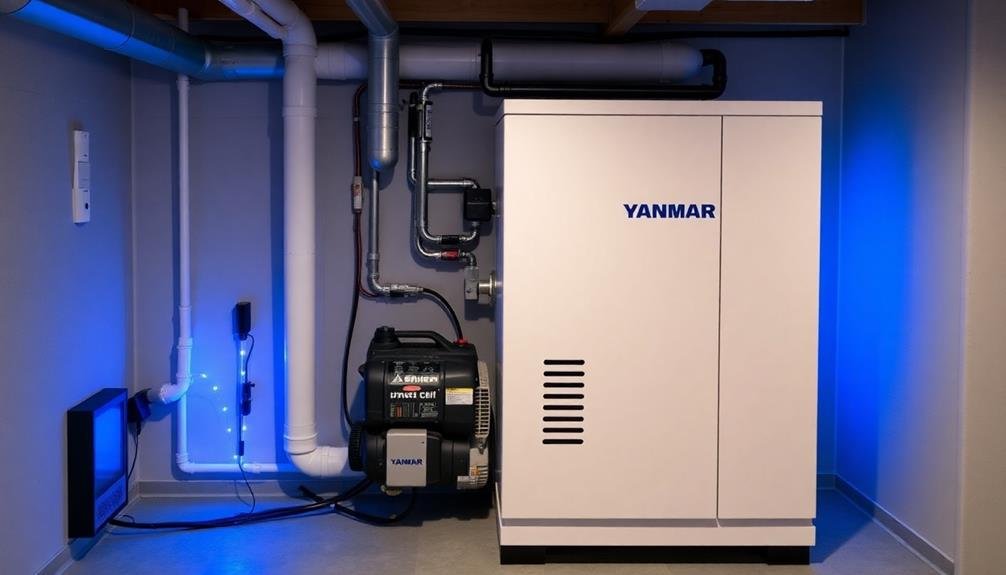
Yanmar's CP5WN model stands out as a high-efficiency micro-CHP system designed for residential use. This natural gas-powered unit can generate up to 5kW of electricity while simultaneously producing hot water for your home.
You'll appreciate its compact design, measuring just 1,000 x 660 x 1,480 mm, making it easy to install in various locations.
The CP5WN boasts an impressive overall efficiency of 85%, with 26% electrical efficiency and 59% thermal efficiency. It's equipped with a lean-burn gas engine that guarantees low emissions and quiet operation, making it suitable for urban environments.
You can expect annual CO2 reductions of up to 5 tons compared to conventional energy sources.
One of the CP5WN's key features is its ability to modulate output based on your home's energy demands. This flexibility allows you to optimize energy production and consumption throughout the year.
The system also includes a user-friendly control panel that lets you monitor performance and adjust settings easily.
Yanmar offers a thorough warranty and maintenance program, guaranteeing your CP5WN operates reliably for years to come.
With its blend of efficiency, performance, and eco-friendliness, the Yanmar CP5WN is an excellent choice for homeowners seeking a sustainable energy solution.
Honda MCHP1.0K2
When considering the Honda MCHP1.0K2 micro-CHP system, you'll find it offers impressive efficiency and power output for residential use.
You can expect a straightforward installation process and minimal maintenance requirements, making it a user-friendly option for homeowners.
While the initial cost may be significant, you'll likely see substantial energy savings over time, potentially offsetting the investment.
Efficiency and Power Output
In terms of efficiency and power output, the Honda MCHP1.0K2 stands out as a top performer in the micro-CHP market. This system boasts an impressive overall efficiency of up to 85%, which means you'll be making the most of your fuel input. It generates 1.0 kW of electrical power and 2.5 kW of thermal energy, providing a balanced output for your home's needs.
The Honda MCHP1.0K2's high efficiency is attributed to several key factors:
- Advanced engine technology: Honda's expertise in combustion engines guarantees peak fuel utilization.
- Heat recovery system: Waste heat is effectively captured and repurposed for heating and hot water.
- Intelligent control system: The unit adjusts its output based on your home's demand, maximizing efficiency.
You'll appreciate the system's ability to meet your household's electricity requirements while simultaneously fulfilling your heating and hot water needs.
This dual functionality not only reduces your reliance on the grid but also lowers your overall energy costs. The Honda MCHP1.0K2's power output is designed to cater to the average household, making it an ideal choice for eco-conscious homeowners looking to reduce their carbon footprint without compromising on comfort or convenience.
Installation and Maintenance
Installation of the Honda MCHP1.0K2 is a straightforward process that requires professional expertise. You'll need to hire a certified technician to guarantee proper setup and compliance with local regulations. The system connects to your home's existing natural gas line and electrical system.
It's typically installed outdoors, similar to a central air conditioning unit, and requires adequate ventilation.
Once installed, the Honda MCHP1.0K2 is designed for low maintenance. You'll need to schedule annual checkups with a qualified technician to keep the system running efficiently. These inspections include cleaning or replacing air filters, checking electrical connections, and guaranteeing proper fuel flow.
The unit's self-diagnostic system alerts you to potential issues, allowing for prompt attention. You can monitor the system's performance through a user-friendly interface, which provides real-time data on energy production and consumption.
While the Honda MCHP1.0K2 is built to last, you may need to replace certain components over time. The engine's spark plugs and oil should be changed every 6,000 operating hours, which typically equates to every 2-3 years for most households.
With proper care, your micro-CHP system can provide reliable, eco-friendly energy for up to 20 years.
Cost and Energy Savings
The Honda MCHP1.0K2 offers substantial cost and energy savings for homeowners. You'll see a significant reduction in your energy bills as this micro-CHP system generates both heat and electricity simultaneously. By utilizing waste heat from electricity production, it achieves an impressive overall efficiency of up to 85%, far surpassing traditional power plants.
When you invest in the Honda MCHP1.0K2, you'll benefit from:
- Lower utility costs: The system can potentially cut your annual energy expenses by 30-40%.
- Reduced carbon footprint: You'll decrease your home's CO2 emissions by up to 30% compared to conventional energy sources.
- Energy independence: You'll have a reliable power source during grid outages, enhancing your home's resilience.
The initial cost of the Honda MCHP1.0K2 may seem high, but you'll recoup your investment through long-term savings. Depending on your energy consumption and local utility rates, you can expect a payback period of 3-5 years.
Additionally, you might qualify for government incentives or tax credits, further offsetting the upfront costs and accelerating your return on investment.
Senertec Dachs G5.5
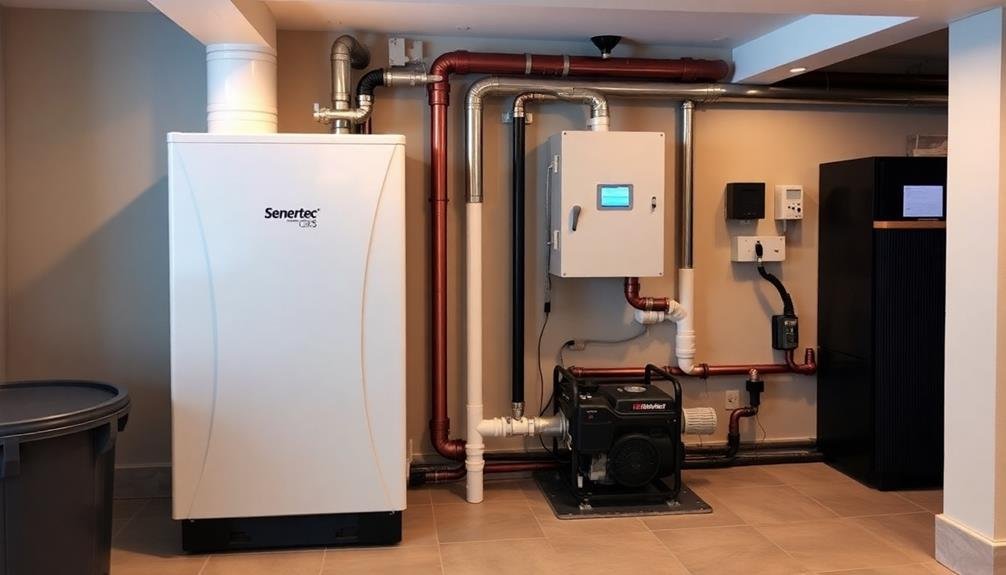
Senertec's Dachs G5.5 stands out as a leading micro-CHP system for residential use. This German-engineered powerhouse offers exceptional efficiency and reliability for your home energy needs. With its compact design, you'll find it easy to integrate into your existing setup.
The Dachs G5.5 uses natural gas or propane to generate both electricity and heat simultaneously. You'll benefit from its 5.5 kW electrical output and 14.8 kW thermal output, making it suitable for most single-family homes. It's designed to operate quietly, ensuring minimal disruption to your daily life.
Here's a quick overview of the Dachs G5.5's key features:
| Feature | Specification | Benefit |
|---|---|---|
| Electrical Output | 5.5 kW | Powers most homes |
| Thermal Output | 14.8 kW | Efficient heating |
| Fuel Type | Natural gas/LPG | Flexible fuel options |
You'll appreciate the system's smart controls, which optimize performance based on your energy demands. It's also compatible with renewable energy sources, allowing you to create a hybrid system if desired. With its high efficiency and low emissions, the Dachs G5.5 can greatly reduce your carbon footprint while providing reliable power and heat for your home.
EC Power XRGI 15
Another prominent player in the micro-CHP market is EC Power's XRGI 15. This Danish-made system is designed for larger residential and small commercial applications, offering a higher power output than many of its competitors.
With an electrical capacity of 15 kW and thermal output of up to 30 kW, the XRGI 15 can efficiently meet the energy demands of bigger properties.
You'll find that the EC Power XRGI 15 stands out for its:
- Flexibility: It can run on natural gas, biogas, or LPG, giving you options based on your local fuel availability.
- High efficiency: The system achieves overall efficiency rates of up to 93%, guaranteeing you get the most out of your fuel.
- Remote monitoring: You can easily track and optimize your system's performance through EC Power's online platform.
The XRGI 15 uses a Toyota-based engine, known for its reliability and longevity.
It's equipped with advanced heat recovery systems that capture waste heat from the engine and exhaust gases, maximizing energy utilization.
You'll appreciate its compact design, which allows for easy installation in various spaces.
The unit's noise-reduction features guarantee quiet operation, making it suitable for residential settings.
Aisin GECC60A2N

From among the lineup of micro-CHP systems, Aisin's GECC60A2N stands out as a robust and efficient option for residential and light commercial applications. This natural gas-powered unit delivers 6 kW of electrical output and 11.7 kW of thermal output, making it ideal for meeting your home's energy needs while reducing your carbon footprint.
The GECC60A2N boasts an impressive overall efficiency of 90%, ensuring you'll get the most out of your fuel. It's designed for easy installation and maintenance, with a compact footprint that won't take up much space in your home. You'll appreciate its quiet operation and long service intervals, which mean less hassle for you.
| Feature | Specification | Benefit |
|---|---|---|
| Electrical Output | 6 kW | Powers most homes |
| Thermal Output | 11.7 kW | Provides ample heat |
| Overall Efficiency | 90% | Reduces energy costs |
With the Aisin GECC60A2N, you're not just investing in a reliable energy source; you're contributing to a greener future. Its high efficiency and low emissions make it an environmentally responsible choice for conscious homeowners. By generating your own heat and power, you'll reduce your reliance on the grid and potentially lower your energy bills.
BDR Thermea Microchp
BDR Thermea's micro-CHP offerings bring innovative heating and power solutions to the residential market. Their microCHP systems are designed to efficiently generate both heat and electricity for your home, reducing your carbon footprint and energy costs.
These units use natural gas or LPG as fuel, making them a versatile option for various household setups.
When you're considering a BDR Thermea microCHP system, you'll find several advantages:
- High efficiency: The systems can achieve overall efficiencies of up to 90%, considerably higher than traditional heating methods.
- Smart technology: BDR Thermea's units incorporate advanced controls that optimize performance based on your home's energy demands.
- Compact design: These systems are designed to fit seamlessly into your home, taking up minimal space while providing maximum benefits.
You'll appreciate the reliability of BDR Thermea's microCHP systems, which are built to last and require minimal maintenance.
They're also compatible with existing heating systems, making installation straightforward. By choosing a BDR Thermea microCHP unit, you're investing in a sustainable energy solution that'll reduce your reliance on the grid and help you become more energy independent.
Ceres Power SteelCell
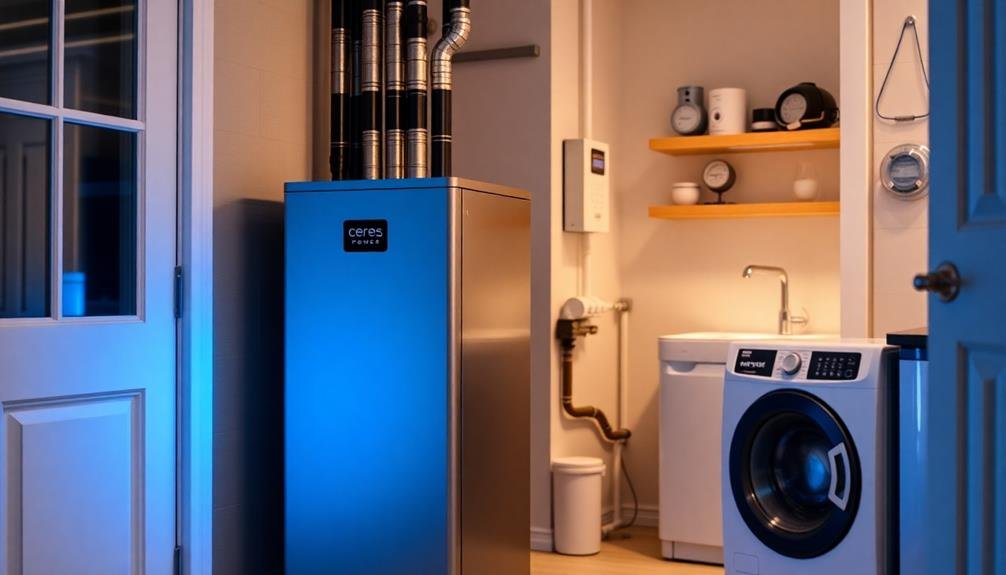
Ceres Power's SteelCell technology represents a significant leap forward in fuel cell innovation. This solid oxide fuel cell (SOFC) system offers high efficiency and fuel flexibility, making it an attractive option for micro-CHP applications. You'll find that the SteelCell can operate on natural gas, biogas, or hydrogen, giving you versatility in your energy choices.
The SteelCell's unique design uses low-cost materials and standard manufacturing processes, which helps reduce production costs. You'll benefit from its compact size and ability to generate both electricity and heat for your home. The system's modular nature allows for scalability, so you can adjust your energy production as needed.
Here's a quick overview of the SteelCell's key features:
| Feature | Benefit | Application |
|---|---|---|
| Fuel flexibility | Use various fuel sources | Adaptable to different regions |
| High efficiency | Lower energy costs | Reduced carbon footprint |
| Scalable design | Customizable output | Suitable for various home sizes |
With its impressive performance and potential for cost-effective mass production, the Ceres Power SteelCell is poised to play a significant role in the future of micro-CHP systems for eco-friendly home energy solutions.
Panasonic Ene-Farm
Have you heard about Panasonic's innovative Ene-Farm system? This micro-CHP technology is revolutionizing home energy production in Japan. The Ene-Farm uses a fuel cell to generate both electricity and heat from natural gas or propane, making it an efficient and eco-friendly option for residential power.
You'll find that Panasonic's Ene-Farm system offers several key advantages:
- High efficiency: It converts up to 95% of the fuel's energy into usable electricity and heat.
- Reduced carbon emissions: The system can cut CO2 emissions by up to 50% compared to conventional power sources.
- Cost savings: Users can expect to lower their energy bills by 30-40% annually.
The Ene-Farm's compact design makes it suitable for various home sizes, and it operates quietly, ensuring minimal disruption to your daily life.
While it's currently most popular in Japan, Panasonic is working to expand its availability worldwide. As you consider eco-friendly energy options for your home, the Ene-Farm's combination of efficiency, environmental benefits, and cost savings makes it a compelling choice for those looking to reduce their carbon footprint and energy expenses.
Frequently Asked Questions
How Long Does It Take to Install a Micro-Chp System?
You'll typically need 1-3 days for a micro-CHP system installation. The exact time depends on your home's layout, existing infrastructure, and the system's complexity. It's best to consult with a professional installer for a precise estimate.
What Maintenance Is Required for Micro-Chp Systems?
You'll need to perform regular maintenance on your micro-CHP system. This includes annual inspections, cleaning filters, checking fluid levels, and replacing worn parts. You should also monitor performance and schedule professional servicing every few years for maximum efficiency.
Can Micro-Chp Systems Be Integrated With Existing Heating Systems?
Yes, you can integrate micro-CHP systems with your existing heating setup. They'll work alongside your current boiler or furnace, enhancing efficiency. You'll need a professional to properly connect and configure the systems for ideal performance.
Are There Government Incentives for Installing Micro-Chp Systems?
Yes, you'll often find government incentives for micro-CHP systems. Check with your local energy office for available tax credits, rebates, or grants. These incentives can greatly reduce your installation costs and make the investment more attractive.
How Noisy Are Micro-Chp Systems During Operation?
You'll find that micro-CHP systems are generally quiet during operation. They're designed to run smoothly, often producing noise levels similar to a refrigerator. However, exact noise levels can vary depending on the specific model and installation.
In Summary
You've now explored some of the top micro-CHP systems for eco-friendly home energy. These innovative units can help you reduce your carbon footprint and energy bills. Whether you're looking for a gas-powered system or a fuel cell option, there's likely a solution that fits your needs. As technology advances, expect even more efficient and affordable micro-CHP systems to hit the market. Consider making the switch to one of these systems for a greener, more self-sufficient home.

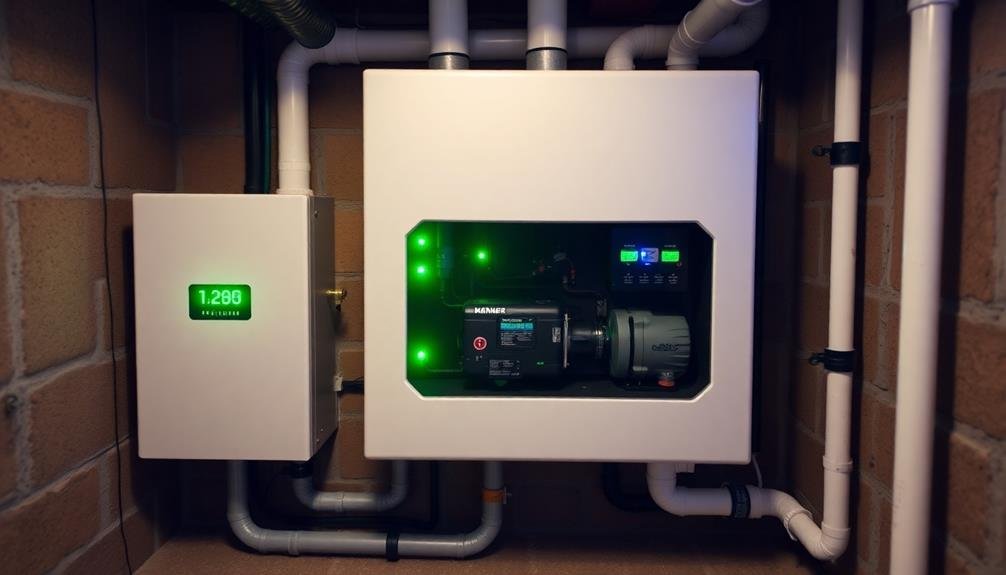



Leave a Reply